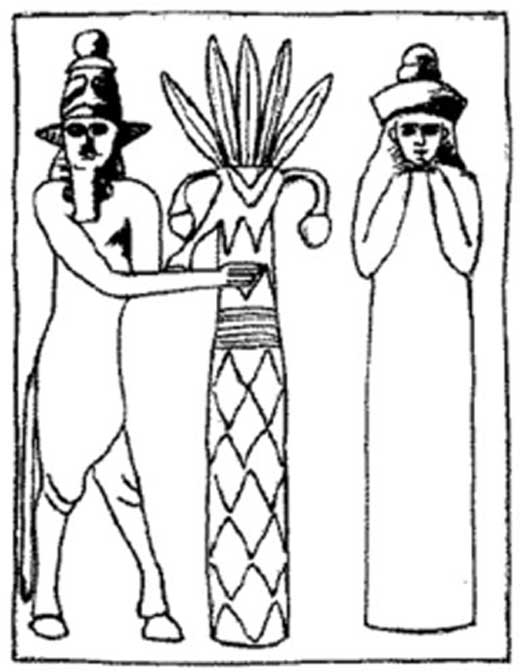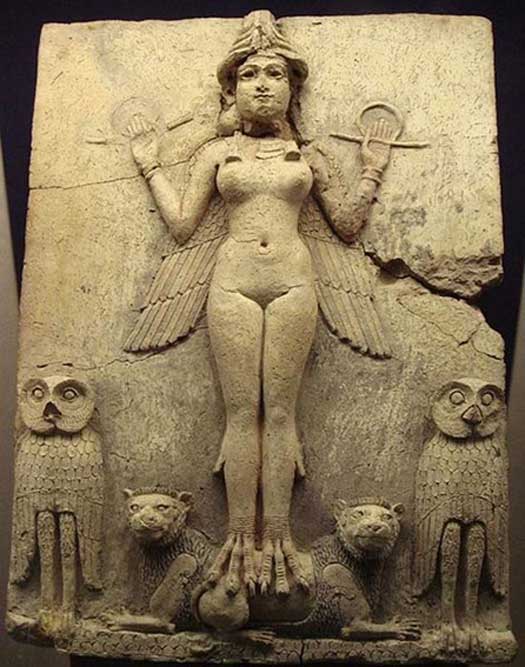
Enki: The Epic Mesopotamian Water God Who Saved Humanity
In the belief system of the Sumerians, Enki (known also as Ea by the Akkadians and Babylonians) was regarded to be one of the most important deities. Originally Enki was worshipped as a god of fresh water and served as the patron deity of the city of Eridu (which the ancient Mesopotamians believe was the first city to have been established in the world).
Over time, however, Enki’s influence grew and this deity was considered to have power over many other aspects of life, including trickery and mischief, magic, creation, fertility, and intelligence. The Neo-Sumerian text Enmerkar and the Lord of Aratta praises a later version of Enki:
“Enki, the lord of abundance and of steadfast decisions, the wise and knowing lord of the Land, the expert of the gods, chosen for wisdom, the lord of Eridug, shall change the speech in their mouths, as many as he had placed there, and so the speech of mankind is truly one.”
Sumerian, Akkadian, and Babylonian Myths of Enki’s Family
According to the Sumerians (and Akkadians), Enki was the son of Anu, the god of the sky. In the Babylonian Enuma Elish , on the other hand, Enki is referred to as the son of Apsu, the primeval freshwater ocean beneath the earth.
Enki has also been regarded as the son of Nammu, the primordial mother goddess who gave birth to the heavens and the earth. Enki’s wife was Ninhursag, and amongst their children are Asarluhi, Enbilulu, and Marduk.

Lord of the Waters. (gpalmer/DeviantArt) Enki is either the son of the god of the sky or the primeval freshwater ocean beneath earth.
A lot of what we know today about Enki comes from the literary works of Mesopotamia that have survived over the millennia. There are a number of stories in which Enki plays a predominant role. One of the most famous of these is the Enuma Elish, the Babylonian creation story.
- Goddess Ninkharsag—Ancient Powerful Mother who Faded into The Holy Ghost
- The Sumerian Seven: The Top-Ranking Gods in the Sumerian Pantheon
- Leaving an Impression: Revealing the Intricate Story of Sumerian Cylinder Seals
In this tale, Enki was an offspring of Apsu and Tiamat, the personifications of fresh water and saltwater, respectively. Enki and his siblings began making a lot of noise, which angered Apsu as it interrupted his sleep. Apsu decided to destroy his children, though his plan was revealed to Enki by Tiamat. As a result, Enki decided to strike first by putting his father to sleep and then killing him. Although the story continues, Enki is no longer the main character in it, as he is overshadowed by his son, Marduk.

A possible depiction of Enki and Ziusudra. (solvo/CC BY ND 2.0)
Enki Helps Humanity
Enki also plays a major role in another Akkadian/Babylonian myth, the Atrahasis, which is the Mesopotamian version of the Great Flood. In this myth, Enki was responsible for the creation of mankind, who would serve the gods.
This race of humans multiplied quickly, and Enlil, the chief deity, became irritated by the amount of noise they made. Therefore, he decided to reduce the number of humans by sending catastrophes to kill them. Each time, however, the people appealed to Enki, who would tell them what to do in order to survive.

Metaphorical creation of man. ( Людмила Прокопенко /Adobe Stock)
Finally, Enlil decides to wipe out humankind once and for all with a great flood. Enki is unable to stop Enlil’s plan and decides to go to earth to save one good man, Atrahasis. The man is told to build an ark and therefore manages to escape from Enlil’s wrath.
The rest of the human race, however, is destroyed. Enlil then suggests that human beings be made again, though these new creations would be less fertile, have a shorter lifespan, and would be more vulnerable than their predecessors.

Reproduction of a seal representing the Sumerian god Enlil and his wife, the goddess Ninlil. (Public Domain)
Enki as a Trickster and One Who is Tricked
In some myths, Enki is regarded as the father of the goddess Inanna, another major deity in the Sumerian pantheon. For example, in the well-known myth, The Descent of Inanna, a plan is devised by Enki to rescue his daughter from the Underworld when she is killed by Ereshkigal, her sister. He sends demons to trick Ereshkigal into giving them Inanna’s corpse, which they then resurrect.
- The Sumerian King List still puzzles historians after more than a century of research
- Oneiromancy and Dream Predictions from Ancient Mesopotamia
- Iraqi Transport Minister Announces that Sumerians Launched Spaceships 7,000 Years Ago
In a myth which is entitled Inanna and Enki , the two deities engage in a drinking competition, during which Enki, who was completely drunk, gives his daughter all the Mes, i.e. the gifts of civilization. The next morning, when Enki realizes what he had done, he sent his followers to retrieve the Mes. Inanna, however, had returned safely to her city, Uruk. Realizing that he had been tricked, Enki had no choice but to make peace with Inanna and the city of Uruk.

“Queen of the Night” relief. The depicted figure could be an aspect of the goddess Ishtar (Sumerian: Inanna) Mesopotamian goddess of sexual love and war. (Public Domain)
In the myths above, it may be said that Enki was perceived as a wise and benevolent god who cared for humanity. In addition, it may be said that his strength laid in his cunning and his ability as a trickster. Nevertheless, as the last example demonstrates, even the trickster may at times be tricked.

An image of Enki from the Adda cylinder seal. (The British Museum/ CC BY NC SA 4.0)
Top Image: A bearded figure in Mesopotamian Art (Paolo Gallo /Adobe Stock) in front of a sun reflected on the sea. (la source de l'info /Adobe Stock) Enki was a water god who was transformed into a more powerful creator deity.
By: Wu Mingren
References
Anon., Atrahasis
[Dalley, S. (trans.), 2008. Atrahasis, in Myths from Mesopotamia, Creation, the Flood, Gilgamesh, and Others. Oxford: Oxford University Press.]
Anon., Inanna and Enki [Online]
[The Electronic Text Corpus of Sumerian Literature, Faculty of Oriental Studies, University of Oxford (trans.), 2002. Inanna and Enki.]
Available at: http://etcsl.orinst.ox.ac.uk/cgi-bin/etcsl.cgi?text=t.1.3.1&charenc=j#
Anon., Inanna’s Descent to the Nether World [Online]
[The Electronic Text Corpus of Sumerian Literature, Faculty of Oriental Studies, University of Oxford (trans.), 2002. Inanna’s Descent to the Nether World.]
Available at: http://etcsl.orinst.ox.ac.uk/section1/tr141.htm
Anon., The Epic of Creation
[Dalley, S. (trans.), 2008. The Epic of Creation, in Myths from Mesopotamia, Creation, the Flood, Gilgamesh, and Others. Oxford: Oxford University Press.]
Horry, R., 2016. Enki/Ea (god). [Online]
Available at: http://oracc.museum.upenn.edu/amgg/listofdeities/enki/
Spar, I., 2009. Epic of Creation (Mesopotamia). [Online]
Available at: http://www.metmuseum.org/toah/hd/epic/hd_epic.htm
















Comments
Giving further credence to the Hebrew God's earlier connotations would be his relationship to the goddess Asherah. The pottery inscriptions found in Kuntillet Ajrud speaking of, "Yahweh and his Asherah" as well as the book of Kings found in the Torah mentioning women weaving textiles for Asherah suggest an early transition from the old married God to Israel's celabite divine creator
Mythology is correct in noting that Baal, El, Enlil and Enki have been recast as Genesis’ God, Yahweh-Elohim. Genesis seems to be an Anti-Thesis, in response to and in refutation of, an earlier Mesopotamian Thesis about how man came to be created and why, in a location called Edin by the Sumerians. Eden’s God is also a recast of Canaanite gods, El and Baal, in addition to Sumerian and Babylonian gods.
Walter R. Mattfeld
Interestingly the hebrew god is believed to be a mixture of Baal, El, Enlil and Enki with their more risque associations removed
Some scholars understand that Noah’s Flood is a recast of the Flood appearing in the Epic of Gilgamesh and Epic of Atrahasis. Enki (Ea) of Eridu warns one man of the flood to destroy mankind and to build a boat and put the seed of man and animals on board for a recovery of life after the flood. In the Bible it is God who does this. In other myths Enki (Ea) at Dilmun is portrayed having sex with his daughter, grand-daughter and great-grand-daughter, in other words incestuous sex of a pedophile nature. In other myths Enki (Ea) is portrayed as being a drunkard when he entertains Inanna of Uruk on a state visit to his abode at Eridu. All this is to say, that the Bible’s God, being a recast of Enki/Ea, means God was, in pre-biblical myths a rapist, a pedophile, having incestuous sex with his daughters, and a drunkard. I can see why the Hebrews would recast this god as unmarried, without any children, and without any other gods or goddesses being in existence. Yahweh-Elohim is portrayed as a God who has no sexual urges, and does not lust after beautiful maidens like the gods of the Sumerian EDIN. How many today would want to worship God if they knew he had been such an unsavory, loathsome character in the pre-biblical Mesopotamian myths?
Walter R. Mattfeld